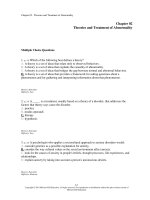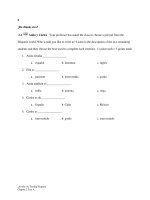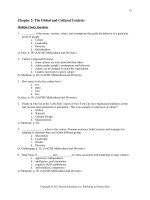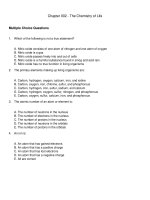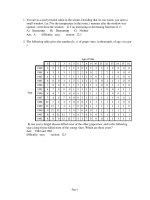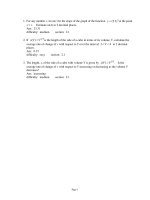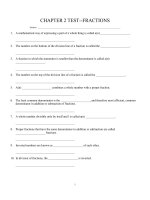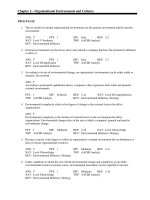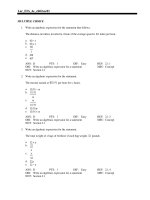Calculus single and multivariable 6th edition hughes hallett test bank
Bạn đang xem bản rút gọn của tài liệu. Xem và tải ngay bản đầy đủ của tài liệu tại đây (401.66 KB, 36 trang )
1. For any number r, let m(r) be the slope of the graph of the function y (2.3) x at the point
x = r. Estimate m(4) to 2 decimal places.
Ans: 23.31
difficulty: medium
section: 2.1
2. If x(V ) V 1/3 is the length of the side of a cube in terms of its volume, V, calculate the
average rate of change of x with respect to V over the interval 3 V 4 to 2 decimal
places.
Ans: 0.15
difficulty: easy
section: 2.1
3. The length, x, of the side of a cube with volume V is given by x(V ) V 1/3 . Is the
average rate of change of x with respect to V increasing or decreasing as the volume V
decreases?
Ans: increasing
difficulty: medium
section: 2.1
Page 1
Chapter 2: Key Concept: The Derivative
4. If the graph of y = f(x) is shown below, arrange the following in ascending order with 1
representing the smallest value and 6 the largest.
A.
E.
f '( A)
1
F.
B.
0
Part A: 6
Part B: 3
Part C: 2
Part D: 4
Part E: 5
Part F: 1
difficulty: medium
f '( B)
C.
f '(C)
D. slope of AB
section: 2.1
5. The height of an object in feet above the ground is given in the following table.
Compute the average velocity over the interval 1 t 3.
t (sec)
y (feet)
0
10
Ans: 20
difficulty: easy
1
45
2
70
3
85
section: 2.1
Page 2
4
90
5
85
6
70
Chapter 2: Key Concept: The Derivative
6. The height of an object in feet above the ground is given in the following table. If
heights of the object are cut in half, how does the average velocity change, over a given
interval?
t (sec)
y (feet)
0
10
1
45
2
70
A) It is cut in half.
B) It is doubled.
Ans: A
difficulty: medium
3
85
4
90
5
85
6
70
C) It remains the same.
D) It depends on the interval.
section: 2.1
7. The height of an object in feet above the ground is given in the following table, y f (t ) .
Make a graph of f (t ) . On your graph , what does the average velocity over a the
interval 0 t 3 represent?
t (sec)
y (feet)
A)
B)
C)
D)
Ans:
0
10
1
45
2
70
3
85
4
90
5
85
6
70
The average height between f(0) and f(3).
The slope of the line between the points (0, f(0)), and (3, f(3)).
The average of the slopes of the tangent lines to the points (0, f(0)), and (3, f(3)).
The distance between the points (0, f(0)), and (3, f(3)).
B
difficulty: medium
section: 2.1
Page 3
Chapter 2: Key Concept: The Derivative
8. The graph of p(t), in the following figure, gives the position of a particle p at time t. List
the following quantities in order, smallest to largest with 1 representing the smallest
value.
A. Average velocity on 1 t 3.
B. Instantaneous velocity at t = 1.
C. Instantaneous velocity at t = 3.
Part A: 2
Part B: 3
Part C: 1
difficulty: medium
section: 2.1
(6 h)2 36
to 2 decimal places by substituting smaller and smaller
h
h0
values of h.
Ans: 12
difficulty: easy
section: 2.1
9. Estimate lim
sin(h 2 )
to 2 decimal places by substituting smaller and smaller values of h
h
h0
(use radians).
Ans: 0
difficulty: easy
section: 2.1
10. Estimate lim
Page 4
Chapter 2: Key Concept: The Derivative
11. A runner planned her strategy for running a half marathon, a distance of 13.1 miles. She
planned to run negative splits, faster speeds as time passed during the race. In the actual
race, she ran the first 6 miles in 48 minutes, the second 4 miles in 28 minutes and the last
3.1 miles in 18 minutes. What was her average velocity over the first 6 miles? What
was her average velocity over the entire race? Did she run negative splits?
A) 7.50 mph for the first 5 miles, 8.36 mph for the race, No
B) 8.36 mph for the first 5 miles, 7.50 mph for the race, No
C) 8.12 mph for the first 5 miles, 7.35 mph for the race, Yes
D) 7.35 mph for the first 5 miles, 8.12 mph for the race, No
Ans: A
difficulty: medium
section: 2.1
12. Let f ( x) x 2 / 3 . Use a graph to decide which one of the following statements is true.
A) When x = -5, the derivative is negative; when x = 5, the derivative is positive; and
as x approaches infinity, the derivative approaches 0.
B) When x = -6, the derivative is positive; when x = 6, the derivative is also positive,
and as x approaches infinity, the derivative approaches 0.
C) When x = -7, the derivative is negative; when x = 7, the derivative is positive, and
as x approaches infinity, the derivative approaches infinity.
D) The derivative is positive at at all values of x.
Ans: A
difficulty: easy
section: 2.1
13. Given the following data about a function f, estimate f '(4.75) .
x
f(x)
3
10
Ans: –4
difficulty: medium
3.5
8
4
7
4.5
4
5
2
5.5
0
6
-1
section: 2.2
14. Given the following data about a function f(x), the equation of the tangent line at x = 5
is approximated by
x
3
3.5
4
4.5
5
5.5
6
f(x)
10
8
7
4
2
0
-1
y 5 –4( x 2)
A)
y 5 –8( x 2)
B)
Ans: C
difficulty: medium
y 2 –4( x 5)
C)
y 2 –8( x 5)
D)
section: 2.2
15. For f ( x) 2 x , estimate f '(0) to 3 decimal places.
Ans: –0.693
difficulty: medium
section: 2.2
Page 5
Chapter 2: Key Concept: The Derivative
16. Let f(x) = log(log(x)). Estimate f '(7) to 3 decimal places using any method.
Ans: 0.032
difficulty: hard
section: 2.2
17. For f ( x) log x , estimate f (3) to 3 decimal places by finding the average slope over
intervals containing the value x = 3.
Ans: 0.145
difficulty: medium
section: 2.2
18. There is a function used by statisticians, called the error function, which is written y = erf
(x). Suppose you have a statistical calculator, which has a button for this function.
Playing with your calculator, you discover the following:
x
erf(x)
1
0.29793972
0.1
0.03976165
0.01
0.00398929
0.001
0.000398942
0
0
Using this information alone, give an estimate for erf(0), the derivative of erf at x = 0 to
4 decimal places.
Ans: 0.3989
difficulty: medium
section: 2.2
Page 6
Chapter 2: Key Concept: The Derivative
19. In the picture
the quantity f '(a+h) is represented by
A) the slope of the line TV
D) the length of the line TV.
B) the area of the rectangle PQRS
E) the slope of the line QU.
C) the slope of the line RU.
F)
the length of the line QU.
Ans: A
difficulty: medium
section: 2.2
20. Given the following table of values for a Bessel function, J 0 ( x) , estimate the derivative
at x = 0.5.
x
0
0.1
0.2
0.3
0.4
0.5
0.6
0.7
0.8
1.0 .9975 .9900
.9776
.9604
.9385
.9120
.8812 .8463
J 0 ( x)
Ans: –0.242
difficulty: medium
section: 2.2
21. The data in the table report the average improvement in scores of six college freshmen
who took a writing assessment before and again after they had x hours of tutoring by a
tutor trained in a new method of instruction. When f(x)>0 the group showed
improvement on average.
x
2
3.5
5
6.5
8
9.5
11
f(x) -2
-1
0
3
7
9
10
a) Find the average change in score from 6.5 to 9.5 hours of tutoring.
b) Estimate the instantaneous rate of change at 8 hours.
c) Approximate the equation of the tangent line at x = 8 hours.
d) Use the tangent line to estimate f(8.5).
Ans: a) 2.00 points, b) 2.00 points, but answers may vary; c) y 7 2.00( x 8) ; d)
8 points
difficulty: medium
section: 2.2
Page 7
0.9
.8075
Chapter 2: Key Concept: The Derivative
22. Use the graph of 5.5e3 x at the point (0, 5.5) to estimate f (0) to three decimal places.
A) 16.500
B) 36.823
C) 3.500
D) 146.507
Ans: A
difficulty: easy
section: 2.2
23. A horticulturist conducted an experiment to determine the effects of different amounts of
fertilizer on the yield of a plot of green onions. He modeled his results with the function
Y ( x) 0.5( x 2)2 5 where Y is the yield in bushels and x is the amount of fertilizer in
pounds. What are Y (0.75) and Y (0.75) ? Give your answers to two decimal places,
specify units.
A) 4.22 bushels, 1.25 bushels/pound, respectively
B) 4.22 bushels, 6.25 bushels/pound, respectively
C) 1.25 bushels, 1.56 bushels/pound, respectively
D) 1.25 bushels, 4.22 bushels/pound, respectively
Ans: A
difficulty: medium
section: 2.2
24. Use the limit of the difference quotient to find the derivative of g ( x)
(1, 11/2).
11
A)
4
Ans: A
11
11
C) -11
D)
2
2
difficulty: medium
section: 2.2
B)
25. Could the first graph, A be the derivative of the second graph, B?
A
Ans: yes
difficulty: medium
B
section: 2.3
Page 8
11
at the point
x 1
Chapter 2: Key Concept: The Derivative
26. Could the first graph, A be the derivative of the second graph, B?
A
Ans: no
difficulty: medium
B
section: 2.3
Page 9
Chapter 2: Key Concept: The Derivative
27. Consider the function y = f(x) graphed below. At the point x = –3, is f '( x) positive,
negative, 0, or undefined?Note: f(x) is defined for -5 < x < 6, except x = 2.
Ans: positive
difficulty: medium
section: 2.3
28. Estimate a formula for f '( x) for the function f ( x) 8x .
decimal places.
Ans: (2.079)8x
difficulty: hard
section: 2.3
Page 10
Round constants to 3
Chapter 2: Key Concept: The Derivative
29. Could the first graph, A be the derivative of the second graph, B?
A
Ans: yes
difficulty: medium
B
section: 2.3
30. Find the derivative of g ( x) 2 x 2 8 x 6 at x = 4 algebraically.
Ans: 24
difficulty: medium
section: 2.3
Page 11
Chapter 2: Key Concept: The Derivative
31. To find the derivative of g ( x) 2 x 2 5 x 9 at x = 8 algebraically, you evaluate the
following expression.
2(8 h) 2 5(8 h) 9 (2 82 5 8 9)
A)
lim
h 0
h
g (8 1) g (8)
B)
h
g (h) g (8)
lim
C)
h
h
D) All of the above are correct.
E) None of the above is correct.
Ans: A
difficulty: medium
section: 2.3
32. Find the derivative of m( x) 3x3 at x = 1 algebraically.
Ans: 9
difficulty: medium
section: 2.3
33. Draw the graph of a continuous function y = g(x) that satisfies the following three
conditions:
•
g(x) = 0 for x < 0
•
g(x) > 0 for 0 < x < 4
•
g(x) < 0 for x > 4
Ans: Answers will vary. One example:
difficulty: medium
section: 2.3
Page 12
Chapter 2: Key Concept: The Derivative
34. The graph below shows the velocity of a bug traveling along a straight line on the
classroom floor.
v meters/sec
4
3
2
1
t sec
1
2
3
4
5
6
7
8
9
10
11
12
-1
-2
-3
-4
-5
At what time(s) does the bug turn around?
A) At 3 seconds.
C)
B) At 2 seconds and again at 7 seconds. D)
Ans: A
difficulty: easy
section: 2.3
Page 13
At 4 seconds and again at 7 seconds.
Never.
Chapter 2: Key Concept: The Derivative
35. The graph below shows the velocity of a bug traveling along a straight line on the
classroom floor.
v meters/sec
4
3
2
1
t sec
1
2
3
4
5
6
7
8
9
10
11
12
-1
-2
-3
-4
-5
When is the bug moving at a constant speed?
A) Between 4 and 7 seconds.
B) Whenever the velocity is linear with a positive slope.
C) Whenever the velocity is linear with a negative slope.
D) When the velocity is equal to zero.
Ans: A
difficulty: easy
section: 2.3
Page 14
Chapter 2: Key Concept: The Derivative
36. he graph below shows the velocity of a bug traveling along a straight line on the
classroom floor.
v meters/sec
4
3
2
1
t sec
1
2
3
4
5
7
6
8
9
10
11
12
-1
-2
-3
-4
-5
Graph the bug's speed at time, t. How does it differ from the bug's velocity?
3
2
1
-1
-2
-3
speed
t
1 2 3 4 5 6 7 8 9 1011
Ans:
Speed is always non-negative, but has the same magnitude as the velocity.
difficulty: medium
section: 2.3
37. Use the definition of the derivative function to find a formula for the slope of the graph of
1
f (t )
.
9t 1
9
Ans:
(9t 1)2
difficulty: hard
section: 2.3
Page 15
Chapter 2: Key Concept: The Derivative
38. What is the equation of the tangent line to the graph of f ( x) x3 at the point (2, 8)?
A) y 12 x 16
B) y 2 x 8
C) y 8x 2
D) y 4 x 64
Ans: A
difficulty: easy
section: 2.3
39. The definition of the derivative function is f ( x)
Ans: False
difficulty: easy
f ( x h) f ( x )
h
section: 2.3
40. A runner competed in a half marathon in Anaheim, a distance of 13.1 miles.
She ran
the first 7 miles at a steady pace in 48 minutes, the second 3 miles at a steady pace in 28
minutes and the last 3.1 miles at a steady pace in 18 minutes.
a) Sketch a well-labeled graph of her distance completed with respect to time.
b) Sketch a well-labeled graph of her velocity with respect to time.
13
12
11
10
9
8
7
6
5
4
3
2
1
distance
velocity mi/min
0.4
0.3
0.2
x
10 20 30 40 50 60 70 80 90
0.1
x
10 20 30 40 50 60 70 80
Ans:
Answers will vary. The graphs above give one possibility.
difficulty: medium
section: 2.3
41. Which of the following is NOT a way to describe the derivative of a function at a point?
A) slope of the tangent line
D) limit of the difference quotient
B) slope of the curve
E) limit of the slopes of secant lines
C) y-intercept of the tangent line
F)
limit of the average rates of change
Ans: C
difficulty: easy
section: 2.3
42. Suppose that f(T) is the cost to heat my house, in dollars per day, when the outside
temperature is T F . If f(28) = 11.10 and f (28) = –0.12, approximately what is the
cost to heat my house when the outside temperature is 25 F ?
Ans: $11.46
difficulty: easy
section: 2.4
Page 16
Chapter 2: Key Concept: The Derivative
43. To study traffic flow along a major road, the city installs a device at the edge of the road
at 1:00a.m. The device counts the cars driving past, and records the total periodically.
The resulting data is plotted on a graph, with time (in hours since installation) on the
horizontal axis and the number of cars on the vertical axis. The graph is shown below; it
is the graph of the function C(t) = Total number of cars that have passed by after t hours.
When is the traffic flow greatest?
A) 2:00 am
B) 3:00 am
C) 4:00 am
D) 5:00 am
Ans: D
difficulty: medium
section: 2.4
44. To study traffic flow along a major road, the city installs a device at the edge of the road
at 3:00a.m. The device counts the cars driving past, and records the total periodically.
The resulting data is plotted on a graph, with time (in hours since installation) on the
horizontal axis and the number of cars on the vertical axis. The graph is shown below; it
is the graph of the function C(t) = Total number of cars that have passed by after t hours.
From the graph, estimate C(6).
A) 600
Ans: A
B) 900
C) 1200
difficulty: medium
D) 1500
section: 2.4
Page 17
Chapter 2: Key Concept: The Derivative
45. Every day the Office of Undergraduate Admissions receives inquiries from eager high
school students. They keep a running account of the number of inquiries received each
day, along with the total number received until that point. Below is a table of weekly
figures from about the end of August to about the end of October of a recent year.
Week of
8/28-9/01
9/04-9/08
9/11-9/15
9/18-9/22
9/25-9/29
10/02-10/06
10/09-10/13
10/16-10/20
10/23-10/27
Inquiries That Total for Year
Week
1085
11,928
1193
13,121
1312
14,433
1443
15,876
1588
17,464
1746
19,210
1921
21,131
2113
23,244
2325
25,569
One of these columns can be interpreted as a rate of change. Which one is it?
A) the first
B) the second
C) the third
Ans: B
difficulty: easy
section: 2.4
46. Every day the Office of Undergraduate Admissions receives inquiries from eager high
school students. They keep a running account of the number of inquiries received each
day, along with the total number received until that point. Below is a table of weekly
figures from about the end of August to about the end of October of a recent year.
Week of
8/28-9/01
9/04-9/08
9/11-9/15
9/18-9/22
9/25-9/29
10/02-10/06
10/09-10/13
10/16-10/20
10/23-10/27
Inquiries That Total for Year
Week
1085
11,928
1193
13,121
1312
14,433
1443
15,876
1588
17,464
1746
19,210
1921
21,131
2113
23,244
2325
25,569
Based on the table determine a formula that approximates the total number of inquiries
received by a given week. Use your formula to estimate how many inquiries the
admissions office will have received by November 24.
Ans: 37,435
difficulty: medium
section: 2.4
Page 18
Chapter 2: Key Concept: The Derivative
47. Let L(r) be the amount of board-feet of lumber produced from a tree of radius r
(measured in inches). What does L(16) mean in practical terms?
A) The amount of board-feet of lumber produced from a tree with a radius of 16
inches.
B) The radius of a tree that will produce 16 board-feet of lumber.
C) The rate of change of the amount of lumber with respect to radius when the radius
is 16 inches (in board-feet per inch).
D) The rate of change of the radius with respect to the amount of lumber produced
when the amount is 16 board-feet (in inches per board-foot).
Ans: A
difficulty: easy
section: 2.4
48. Let t(h) be the temperature in degrees Celsius at a height h (in meters) above the surface
of the earth. What does t '(1200) mean in practical terms?
A) The temperature in degrees Celsius at a height 1200 meters above the surface of the
earth.
B) The height above the surface of the earth at which the temperature is 1200 degrees
Celsius.
C) The rate of change of temperature with respect to height at 1200 meters above the
surface of the earth (in degrees per meter).
D) The rate of change of height with respect to temperature when the temperature is
1200 degrees Celsius (in meters per degree).
Ans: C
difficulty: easy
section: 2.4
49. Let t(h) be the temperature in degrees Celsius at a height of h meters above the surface of
the earth. What does h such that t(h) = 8 mean in practical terms?
A) The temperature in degrees Celsius at a height 8 meters above the surface of the
earth.
B) The height above the surface of the earth at which the temperature is 8 degrees
Celsius.
C) The rate of change of temperature with respect to height at 8 meters above the
surface of the earth (in degrees per meter).
D) The rate of change of height with respect to temperature when the temperature is 8
degrees Celsius (in meters per degree).
Ans: B
difficulty: easy
section: 2.4
Page 19
Chapter 2: Key Concept: The Derivative
50. Let t(h) be the temperature in degrees Celsius at a height of h meters above the surface of
the earth. What does t(h) + 15 mean in practical terms?
A) The temperature in degrees Celsius at a height h meters above the surface of the
earth plus an additional 15 degrees
B) The height above the surface of the earth at which the temperature is h degrees
Celsius plus an additional 15 meters.
C) The rate of change of temperature with respect to height at 15 additional meters
above the surface of the earth (in degrees per meter).
D) The rate of change of height with respect to temperature when the temperature is 15
additional degrees Celsius (in meters per degree).
Ans: A
difficulty: easy
section: 2.4
51. A concert promoter estimates that the cost of printing p full color posters for a major
concert is given by a function Cost = c(p) where p is the number of posters produced.
a) Interpret the meaning of the statement c(450) = 5400.
b) Interpret the meaning of the statement c'(450) = 11.
Ans: a) It costs $5400.00 to produce 450 posters.
b) When 450 posters have been produced, it costs $11.00 to produce an additional
poster.
difficulty: easy
section: 2.4
Page 20
Chapter 2: Key Concept: The Derivative
52. The graph below gives the position of a spider moving along a straight line on the forest
floor for 10 seconds. On the same axes, sketch a graph of the spider's velocity over the
10 seconds. Then write a description of the spider's movement for the 10 second period.
5
p
4
(9, 3) (10, 3)
(5, 3)
(3, 3)
3
2
(7, 1)
1
t
(0, 0)
10
9
8
7
6
5
4
3
2
1
-1
-2
-3
-4
-5
5
p
4
(0, 3)
(3, 3)
(5, 3)
(9, 3) (10, 3)
3
2
(7, 1)
(9, 1)
1
(0, 0)
1
(3, 0)
2
3
4
(5, 0)
5
6
(9, 0)
7
8
-1
-2
-3
-4
-5
Ans:
The dashed line represents the spider's velocity.
Page 21
9
10
t
Chapter 2: Key Concept: The Derivative
For the first three seconds the spider moves forward at 3 feet/sec. It stops for the
next 2 seconds, turns around and goes back in the opposite direction for at a speed
of 1 ft/sec for 2 seconds. It turns around again and goes forward at 1 ft/sec for the
next two seconds, then stops for the final second.
difficulty: medium
section: 2.4
53. A typhoon is a tropical cyclone, like a hurricane, that forms in the northwestern Pacific
Ocean. The wind speed of a typhoon is given by a function W = w(r) where W is
measured in meters/sec., and r is measured in kilometers from the center of the typhoon.
What does the statement that w'(15) > 0 tell you about the typhoon?
A) At a distance of 15 kilometers from the center of the typhoon, the wind speed is
increasing.
B) At a distance of 15 kilometers from the center of the typhoon, the wind speed is
positive.
C) The wind speed of the typhoon is 15 meters per second at any distance from the
center of the typhoon.
Ans: A
difficulty: medium
section: 2.4
54. The cost in dollars to produce q bottles of a prescription skin treatment is given by the
function C (q) 0.08q 2 75q 900 . The manufacturing process is difficult and costly
when large quantities are produced. The marginal cost of producing one additional
dC
bottle when q bottles have been produced is the derivative
.
dq
a) Find the marginal cost function.
b) Compute C(50) and explain what the number means in terms of cost and production.
c) Compute C'(50) and explain what the number means in terms of cost and production.
dC
Ans: a)
0.16q 75
dq
b) C(50) = $4850.00 is the cost of producing 50 bottles of the skin treatment.
c) C'(50) = $83.00 per bottle of the cost of producing an additional bottle when 50
have already been produced.
difficulty: medium
section: 2.4
Page 22
Chapter 2: Key Concept: The Derivative
55. The graph of f ( x) is given in the following figure. What happens to f '( x) at the
point x1 ?
A)
B)
C)
D)
Ans:
f '( x) has an inflection point.
f '( x) has a local minimum or maximum.
f '( x) changes sign.
none of the above
C
difficulty: hard
section: 2.5
56. Esther is a swimmer who prides herself in having a smooth backstroke. Let s(t) be her
position in an Olympic size (50-meter) pool, as a function of time (s(t) is measured in
meters, t is seconds). Below we list some values of s(t) for a recent swim. Find Esther's
average speed over the entire swim in meters per second. Round to 2 decimal places.
t
s(t)
0
0
Ans: 1.64
difficulty: medium
3.0
10
8.6
20
14.64
30
21.35
40
28.06
50
32.33
40
39.04
30
46.36.
20
54.9
10
61
0
53.9
10
60
0
section: 2.5
57. Esther is a swimmer who prides herself in having a smooth backstroke. Let s(t) be her
position in an Olympic size (50-meter) pool, as a function of time (s(t) is measured in
meters, t is seconds). Below we list some values of s(t), for a recent swim. Based on
the data, was Esther's instantaneous speed ever greater than 3 meters/second?
t
s(t)
0
0
Ans: yes
difficulty: medium
3.0
10
8.6
20
14.6
30
section: 2.5
Page 23
20.8
40
27.6
50
31.9
40
38.1
30
45.8
20
Chapter 2: Key Concept: The Derivative
58. The graph below represents the rate of change of a function f with respect to x; i.e., it is a
graph of f . You are told that f (0) = 0. What can you say about f ( x) at the point x =
1.3? Mark all that apply.
A)
f ( x) is decreasing.
B)
f ( x) is increasing.
Ans: A, D
difficulty: easy
C)
D)
section: 2.5
f ( x) is concave up.
f ( x) is concave down.
59. The graph below represents the rate of change of a function f with respect to x; i.e., it is a
graph of f. You are told that f(0) = –2. For approximately what value of x other than x = 0
in the interval 0 x 2 does f ( x) = –2?
A) 0.6
Ans: C
B) 1
C) 1.4
D) 2
E) None of the above
difficulty: medium
section: 2.5
Page 24
Chapter 2: Key Concept: The Derivative
60. On the axes below, sketch a smooth, continuous curve (i.e., no sharp corners, no breaks)
which passes through the point P(5, 6), and which clearly satisfies the following
conditions:
•
Concave up to the left of P
•
Concave down to the right of P
•
Increasing for x > 0
•
Decreasing for x < 0
•
Does not pass through the origin.
5
y
4
3
2
1
-5 -4 -3 -2 -1
-1
x
1
2
3
4
5
-2
-3
-4
-5
Ans: Answers will vary. One possibility:
difficulty: easy
section: 2.5
Page 25
